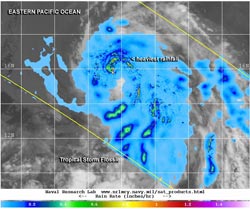NASA Sees Heaviest Rain North of Tropical Storm Flossie's Center

This image shows TRMM rainfall data laid over an infrared image from NOAA's GOES-15 satellite to show rainfall within Flossie's cloud cover. Heaviest rainfall (red) was falling north of the center. Image Credit: NRL/NASA/NOAA<br>
When NASA and the Japan Space Agency's Tropical Rainfall Measuring Mission or TRMM satellite passed over Tropical Storm Flossie, it measured rainfall rates occurring throughout the storm. TRMM noticed that the heaviest rainfall was occurring at a rate of 1.2 inches per hour north of the center. The heavy rain wrapped around the storm from the north to the east. Most of the remaining rainfall was light to moderate. Microwave satellite imagery shows some inner core features trying to form.
An image created at the Naval Research Laboratory, Washington, combined the TRMM data with an infrared image from NOAA's GOES-15 satellite to show rainfall within Flossie's cloud cover. Rain was falling throughout much of the storm.
On Friday, July 26 at 8 a.m. PDT (1500 UTC) the center of Tropical Storm Flossie was located near latitude 16.1 north and longitude 132.3 west, almost mid-way between the southern tip of Baja California and Hilo, Hawaii (about 1,530 miles (2, 465 km) from each place. Maximum sustained winds were near 50 mph (85 kph). Flossie was moving to the west-northwest at 18 mph (30 kph) and had a minimum central pressure of 1,000 millibars.
As Flossie continues its westward track, the National Hurricane Center notes that residents of Hawaii should monitor the storm's approach.
Text credit: Rob Gutro
NASA's Goddard Space Flight Center
Media Contact
More Information:
http://www.nasa.govAll latest news from the category: Earth Sciences
Earth Sciences (also referred to as Geosciences), which deals with basic issues surrounding our planet, plays a vital role in the area of energy and raw materials supply.
Earth Sciences comprises subjects such as geology, geography, geological informatics, paleontology, mineralogy, petrography, crystallography, geophysics, geodesy, glaciology, cartography, photogrammetry, meteorology and seismology, early-warning systems, earthquake research and polar research.
Newest articles

Superradiant atoms could push the boundaries of how precisely time can be measured
Superradiant atoms can help us measure time more precisely than ever. In a new study, researchers from the University of Copenhagen present a new method for measuring the time interval,…

Ion thermoelectric conversion devices for near room temperature
The electrode sheet of the thermoelectric device consists of ionic hydrogel, which is sandwiched between the electrodes to form, and the Prussian blue on the electrode undergoes a redox reaction…

Zap Energy achieves 37-million-degree temperatures in a compact device
New publication reports record electron temperatures for a small-scale, sheared-flow-stabilized Z-pinch fusion device. In the nine decades since humans first produced fusion reactions, only a few fusion technologies have demonstrated…





















